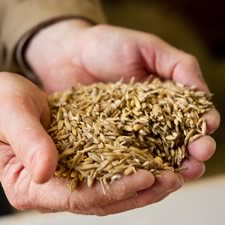Alpaca care
For new and experienced farmers alike, caring for your Alpacas is the single most important part of your day! Here's a few things we've learned….

Signs of a Pending Birth
We carefully research and assess the positive traits of our females and match them with a male who may help overcome any negatives and maintain the positives. After we've decided on the best match, we breed the pair and look for a stunning baby (cria) approximately 335 to 345 days later! We typically plan these births to take place in the spring (May-June) or fall (September-October). During those months we are most likely to have daytime temperatures that help maintain the appropriate temperature of the newborn cria.
So how can you tell if your alpaca is soon to deliver a baby? We track the females' past pregnancies and the length of gestation. That usually gives us an idea of pregnancy length. However, we still begin watching our females on day 335 of the pregnancy. We watch for any or all of the following: rolling, isolating themselves from the herd, rubbing against the fence, humming more than usual, going to the poop pile frequently, a discharge from the vulva area, or not eating their grain. Of course, this requires vigilance! We watch carefully, but we are still surprised sometimes when a healthy little cria comes bouncing down to the barn beside its mother … and we missed the whole thing!

Is He/She Chubby?
If you can use your alpaca's back for a table…she's probably chubby! An alpaca that is too thin or too plump may have difficulty getting and maintaining pregnancy or producing adequate milk for the cria. We weigh our adults monthly and our cria quite frequently. But Body Score offers an even better indicator. We use a rating scale of one (1) – very thin to ten (10) – overweight … like a table. When using this rating scale, the best body score is a five (5).
To analyze an alpaca's body score, position your hand on the backbone of the alpaca just behind the shoulder. The hand should form a nice upside down "V". If your hand is flat, that means chubby and a body score of 8 to 10. A "V" that is concave shows a thinner alpaca with a body score of 2 to 3.
For the Chubby Ones…
We use 9-12% protein hay, continue with the recommended grain amounts, give them more exercise, and in severe cases, we will put them on a dry lot area and manage their food intake closely.
For the Thin Ones…
Thinness can be caused by parasites, illness, shyness that keeps them from a crowded feeder, nursing a cria, stress from a new/changing environment, showing, or transporting. If we've ruled out any health concerns and she is just one of those thin ones, we supplement with higher protein hay and/or alfalfa, put them on good pasture when available, and sometimes supplement their grain with beet pulp at a rate of 1/3 cup per day. Thinness is one of those things that causes us to sit up, take notice, and fix whatever the cause.

Selecting Alpacas
YES – they are cute and sweet, but you want to be an educated buyer! Here's some of the criteria we've used to select for our breeding quality herd.
What you can observe
We observe two major items: conformation and fiber. Conformation is the attributes of the alpaca's body such as a level back, straight legs, solid balanced stance, and so much more.
Fiber attributes vary by alpaca type. Of course, we look at the level of luster and lock structure of the suri. We also look for leg coverage, uniformity of the lock and color, and more. To learn more about conformation and fiber, please contact us!
What you can Research
The Alpaca Registry (alpacaregistry.com) provides the reproductive history and lineage of the alpaca and confirms they are registered, which is critical in a breeding herd. Make sure that males have produced cria that are consistent with their type and that females don't have an unexplained lapse in breeding history.
What about the Breeder
A breeder should learn your goals and offer alpacas that match your goals. They should provide a comprehensive contract for the sale, offer to educate you when needed, and offer to provide the services you may need after the sale.

